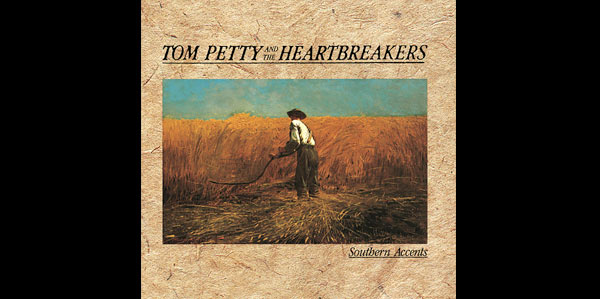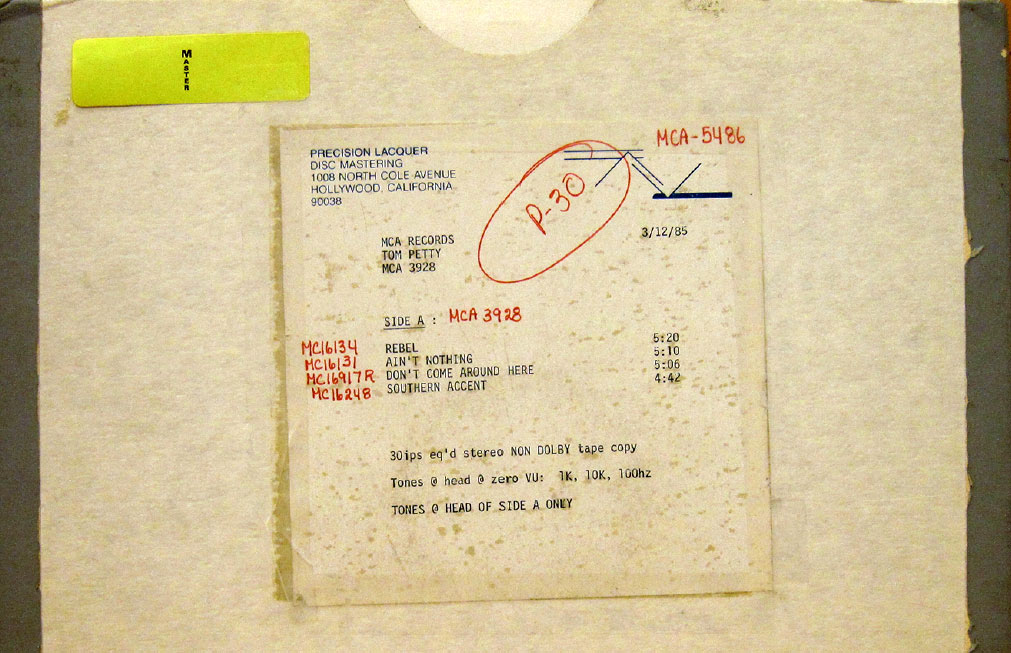Tom Petty: HD-Audio Provenance
I purchased Tom Petty’s “Southern Accents” album from HDtracks yesterday afternoon. There is more dynamic range on these files than current releases and much more than “Hypnotic Eye” album. I’m in the midst of doing a thorough analysis of the new “High-resolution” versions of Tom’s album but the initial news is very much positive.
The “Southern Accents” album has 9 tracks (totaling about 40 minutes) remastered to 96 kHz/24-bit PCM in AIF format by Chris Bellamn of Bernie Grundman Mastering. There is also an accompanying PDF booklet that has a couple of photos or the original tape boxes and a few paragraphs by the supervisor of the project, Ryan Ulyate (Tom’s long time audio engineer).
I’ve copied the photos below so that you can see the information provided on the boxes:
Figure 1 – The “Master” tape box for Side A of Tom Petty’s “Southern Accents” album. [Click to enlarge]
Figure 2 – The “Master” tape box for Side B of Tom Petty’s “Southern Accents” album. [Click to enlarge]
There are a number of important things to notice in these tape boxes. The first is the yellow “post it” sticker that says “Master” on it. And then there’s the label from Stephen Marcussen’s “Precision Lacquer Disc Mastering”, the location where the original mastering work was done. Then there’s the list of tunes and their durations. Of particular interest is the first of the three lines of typed text at the center bottom of the label.
“30ips eq’d stereo NON DOLBY tape copy”
This statement caught my attention for a couple of reasons. The tape has been eq’d. At some stage following the recording of the original mixes (which I would assume would be at 30 ips NON DOLBY as well), an engineer has applied equalization or timbral modifications to the tape. According to the notes from the supervising engineer, they used the “best sounding second generation master” for this album and a couple of others. The reason? Because “the original tape is unplayable.
Therefore, they were forced to use the EQ’d copy from the original mastering from 1976…”so every version of this album that has been released was generated from this tape. This is the sound of this record!”
What is an EQ’d copy? It’s a transfer from the original mixes that has had some tonal changes from the source mixes AND which has most likely been altered to conform to the requirements for vinyl LP duplication. This means the low end has been folded to mono to overcome negative groove cutting (when a low frequency signal on the left or right forces the cutting head to move above the surface of the lacquer).
In the notes that accompany the tracks, Ryan’s producers note says, “The Hi-Res (24bit 96K) remastering of the Tom Petty catalog reveals a level of detail that was only previously heard by a select group of musicians, producers and engineers in the studio. It’s as close to the sound of original stereo master as you can get. We’re very happy with the way it came out, and believe it’s an important way to preserve the legacy of this great body of work.”
I wholeheartedly agree. This is a Master Quality transfer and Tom Petty fans like me will revel in the better sound. But the production of these new transfers required the producers and engineers to accept compromises. The original first generation mixes are “unplayable”…an extremely unfortunate circumstance but not uncommon. The use of an EQ’d master is a compromise that means that we’ll hear the recording they way that is was when it was released on vinyl LP but just imagine if we could listen to the original mixes without the EQ and mono low frequencies. We’ll never know if that might be better or not.
The dynamic range is improved. As Ryan points out, “To allow for full dynamic range, and to let the music ‘breathe’ the Hi-Res versions have about 6-8 dB less digital level than a typical ‘loud’ peak-limited CD or MP3. To enjoy these albums to their fullest extent, play them back though a good system and turn up the volume.”
So sit back and turn up your system, Tom Petty is rocking in Master Quality.




I appreciated your comments on the Tom Petty “Southern Accents” release. While I agree with your definition of HD audio I also never feel cheated if a :High resolution” moniker is attached to a project that is the highest resolution available for a particular recording. I am not anti-digital at all even though I love analog as well. I’ve never been able to tell, after walking back out and into a room, whether I am listening to a 192Khz rip of an LP that I have recorded myself or the original LP. Sometimes I think I can when I know which is playing but I’m never sure when I don’t. Sort of telling I think LOL.
All I want, or believe I can hope for, is that a digital re-release of an LP sound either identical to the record I had or better in some way and I can attest that the Tom Petty re-release of his first album does sound better than the original LP I have. Actually, quite markedly so. Hence, I’m happy 🙂
Sure, it would be great if new recordings were done in a true, high resolution manner but if I can get my old favorites in a new, improved digital format I’m all the happier.
Again, I loved this post. All positives and honest sincere recognition of the work that went into the re-release project. I and I’m sure the project workers appreciate your comments.
All the best to you and keep up te good work.
Don
Very encouraging news Mark, but in these circumstances is 24/96 a sonic advantage over 16/44 or does the remastering, of itself, make all the difference that’s to be gained here?
I believe there is a sonic advantage at 96/24 over CD res…the spectra of the Tom Petty album certainly extends beyond 22 kHz. Things top out at about 25-30 kHz down at -100 dB.
Thanks Mark, this sounds like it’s a job well done and is backed by very solid provenance in terms of how the end result of this release has been arrived at. This is the kind of information that ought to be provided as standard and doubtless makes the “sleeve notes” essential reading for the audiophile.
Hi Mark,
I really enjoyed your more in-depth eval of these selected tracks. Tom Petty is also one of my all-time favorite artist. Unfortunately, I wasn’t listening to music during most of his original releases and I am embarrassed to say most of the tracks I own have been procured in the dark MP3 ages. While I am now more educated about the trade-offs with MP3, I still haven’t gone back and purchased the CD versions. So I am thrilled with these re-releases. I finally get to have the best-sounding Petty available!
My other comment is in response to your observation that “Things top out at about 25-30 kHz down at -100 dB”. In past posts, you are fairly adamant that analog tape sources mastered to 96/24 should not be classified as HD audio. Although I agree your real HD audio tracks have much greater high frequency extension, I wonder whether it is fair to exclude these (and other similar analog tape cases)? It seems an oversimplification to say that source material from analog tape and then mastered in PCM 96/24 can’t be classified as HD audio.
The frequency response of analog tape can exceed the CD spec but it falls terribly short of meeting the needs of real world dynamics. For this reason, analog tape is still no high-resolution by my definition.
Great post, Mark. In your further analysis, are you going to examine the differences in low-end between the channels to try to infer whether the EQ applied was, in fact, mastering for vinyl – rather than some intermediate tweaking.
Thanks…I haven’t taken the downloaded tracks into the studio. I’ve run them through and determined the dynamic range but will have to take a closer look when I get them in the studio.
Whatever, it’s not hi Rez and definitely not worth the $$. Will “reinvented” music ever stop ?
Thanks so much for the info and the analysis. I wish we could have this depth of understanding of all recordings – both original and remasterings – to help in our purchasing decisions. I simply don’t trust the popular reviewers.
I’m working on setting up the HRA Database…it’s going slowly but I’m committed.
At this point, if you are really bent on benefitting the public by exposing falsely labeled products, I’d suggest you walk into the nearest supermarket and put every food item with the word “natural” in your cart. You will quickly find just how “un-natural” many of these products really are. Then, you can go after all those food companies that are deceiving folks on a level much more important than the provenance of recordings.
I too often feel frustrated at the challenge of spreading the gospel of clean sound .Ultimately, many people still learn best ‘the hard way.’ You have to have been around crappy sound to fully appreciate the opposite, and only now with the surging interest in healthier food has the public realized that they have been semi-poisoned or worse all these years dietarily.
.Mark, the old saying applies here:”Water seeks its’ own level” So it shall be with the publics’ reaction to the various true , false, and ‘almost’ iterations of HRA. There is really nothing we can do now but see how things shake out, not worth stressing out about anymore or for using significant column space after so many words have been printed without changing anything.
To the contrary Craig, I get email everyday from the mislead and uninitiated thanking me to the reporting that I do here on this blog. There is plenty left to be said…as long as the providers of so-called “high-resolution” audio continue to push stuff that’s not.
Good news all around. How refreshing to get a marketing release announcement like this that isn’t a 90% BS spin.
Maybe Neil Young could learn a thing or two from Petty and his people. IMHO the best news of all here is that the claimed attention to a improved dynamic range was really true. This kind of improvement would also be immediately audible even on a Blue Book CD. We can only hope this becomes a movement that spreads threw the mastering industry.
I agree that while i would rather have the non eqq’d master this is very good news indeed, even though I am not much of a TP fan. Well done.
“Southern Accents” is not available for download from HDTracks to us in Australia due to “licensing restrictions”. Isn’t that wonderful? And no, there is no alternative supplier AFAICT.
I am not aware of any CD that Amazon has refused to post to us here on that basis.
Yet another obstacle to participating in the hi-res ‘revolution’.
It is a licensing thing. The labels or artist probably have a reason…and it most likely involves money.